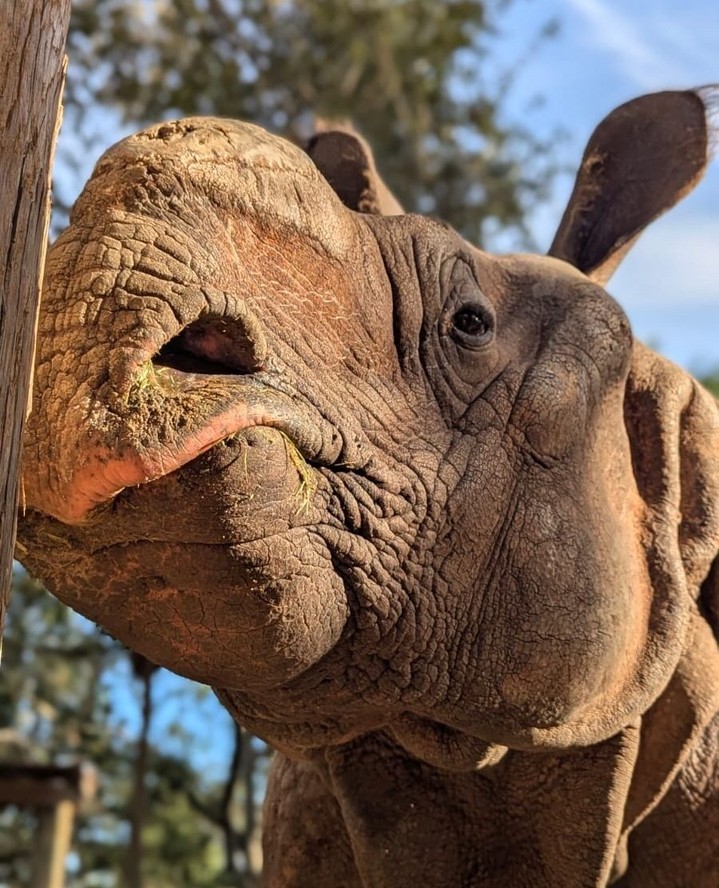- Understanding the anatomy and species characteristics of Greater One-Horned Rhinos.
- The role of zoos, like ZooTampa, in the conservation efforts for Greater One-Horned Rhinos.
- Enhancing horn identification skills to recognize individual rhinos.
- Introducing the three Greater One-Horned Rhinos at ZooTampa and their unique features.
- The importance of public education and community involvement in wildlife conservation.
The Greater One-Horned Rhino, also known as the Indian Rhino, is a spectacular creature that captivates many with its prehistoric appearance and gentle demeanor. In your quest to hone horn identification skills, a foundational understanding of the anatomy and behavioral characteristics of these rhinos is crucial. The body of a Greater One-Horned Rhino is armored with thick, silver-brown skin, which develops into unique plates resembling armor. This formidable exterior is not merely for show—it plays a vital role in protecting the rhino from predators and environmental elements.
Equipped with a single horn, these rhinos differ significantly from their African relatives, who may sport two. This horn is composed of keratin, the same substance found in human hair and nails. Measuring between 8 to 25 cm in length, it is a defining feature that can help enthusiasts distinguish between individual animals. Each horn develops distinct characteristics based on age, environment, and behavior, providing a unique fingerprint for identifying each rhino throughout parks or reserves.
Aiding in the conservation of Greater One-Horned Rhinos is not only an endeavor of passionate individuals but also a key focus of dedicated institutions like ZooTampa. With a focus on education and preservation, zoos play a pivotal role in safeguarding the future of these magnificent creatures. Modern zoos function not just as exhibition spaces but as active conservation hubs that contribute to global efforts for wildlife preservation through captive breeding programs, research, and public awareness campaigns.
ZooTampa is home to three remarkable Greater One-Horned Rhinos: Johnny, Jamie, and Gronk. Each has distinct features that make them important ambassadors for their species. As visitors approach their habitat, the staff at ZooTampa encourages them to notice the differences in horn length and shape. From Johnny’s shorter horn to Jamie’s robust physique and Gronk’s commanding presence, each rhino has something unique to share with visitors, offering a living lesson in wildlife diversity.
Developing the skills to identify rhino horns is more than just a fun exercise—it is an invaluable tool for researchers and conservationists. By learning to recognize the subtle differences in horn shape and size, individuals can contribute valuable data that aids in monitoring rhino populations and understanding their behavior. For conservationists, this data provides insights into the health and dynamics of rhino groups, essential for crafting effective conservation strategies.
ZooTampa’s rhinos offer an excellent opportunity to practice these identification skills, encouraging visitors to look beyond the surface. Through programs and educational displays, the zoo transforms the visit into a learning experience, promoting awareness about the challenges these animals face in the wild, such as habitat loss and poaching. Community involvement is a critical component of conservation efforts, ensuring that the public remains informed and engaged.
Public education is a cornerstone of effective wildlife conservation. It is through understanding that people develop empathy and a desire to participate in conservation efforts. Programs that focus on species awareness and environmental stewardship cultivate a new generation of wildlife advocates. Supporting sustainable practices and conservation initiatives starts with a well-informed public eager to participate in safeguarding biodiversity.
Community participation is crucial. When local communities become stakeholders in conservation projects, they help drive impactful change. Engaging communities in educational ventures about Greater One-Horned Rhinos through local outreach initiatives fosters a sense of pride and responsibility toward preserving natural heritage. This collaborative approach is vital for ensuring that conservation programs remain effective and beneficial to both wildlife and people.
Zoos like ZooTampa engage not only through exhibition but also by organizing workshops and interactive events that emphasize conservation’s importance. By leveraging the power of education, zoos forge connections between humans and animals, nurturing a sense of stewardship and inspiring actionable change toward preserving species like the Greater One-Horned Rhino.
*****
Source Description
Who’s ready to hone in your horn identification skills? 😎
We have three Greater One-Horned Rhinos at ZooTampa: Johnny, Jamie, and Gronk. Of our family of three, Johnny has the shortest horn! 🦏


